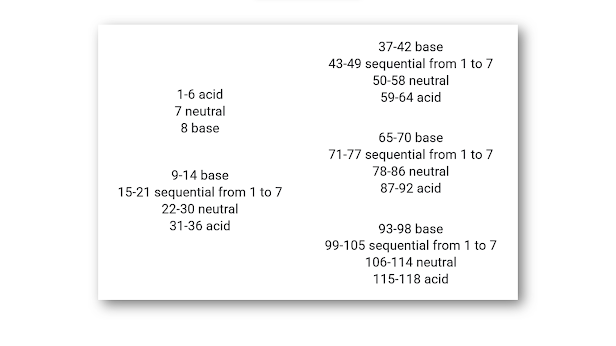 |
| Photo of Litmus Paper Source of picture: sciencestockphotos.com |
In a famous scientific journal, periodic table is defined as:
"A tabular array of the chemical elements organized by atomic number, from the element with the lowest atomic number, hydrogen, to the element with the highest atomic number, organesson" (Britannica, The Editors of Encyclopaedia, 2023)
Periodic table make it easy to see the traits of elements that have same characteristics. Each element in periodic table has pattern of traits that is sequential. For instance, Salangka (1997) said that the electronegativity (ability to pull electrons) in a group, towards the bottom it becomes smaller. While in a period, towards the right it becomes bigger in value.
Same as the example, pH has pattern too in periodic table. This can only be used for checking of pH kinds, not for accurate finding of pH value. The following image represents the pH pattern.
The pattern above can be used to check:
1. Ordinal number of non-neutral elements
2. Ordinal number and one decimal of neutral elements
For example, in sequential pattern, Chlorine (non-neutral element) have atomic number 17. Then we can say it is 3 in pH value. For base pattern, Rubidium, pH value of it is 8 because it owns atomic number of 37. While in the acid pattern we know the atomic number of Bromine is 35. As the result, it has pH value of 5. Other example, for neutral elements: Barium have atomic number 56. So, its pH value is 7.7285.
WARNING!!!
This way of checking pH can only be implemented to elements, not compounds.
That's all we can discuss. I hope this content is always having benefits for all of us. Thank you for visiting my blog!
Bibliography:
Britannica, The Editors of Encyclopaedia. "What is the periodic table?". Encyclopedia Britannica, 4
Oct. 2020, https://www.britannica.com/question/What-is-the-periodic-table. Accessed 4
October 2023.
Salangka, S. Sains Kimia: Rangkuman Lengkap Materi Kurikulum 1994 SMU Kelas I, II, dan III. 1997.
Jakarta: Poliyama Widya Pustaka Jakarta.
P.S. Please cite this blog if you want to copy some parts or all of it.
Do not copy or capture this blog without including the blog link.

Comments
Post a Comment